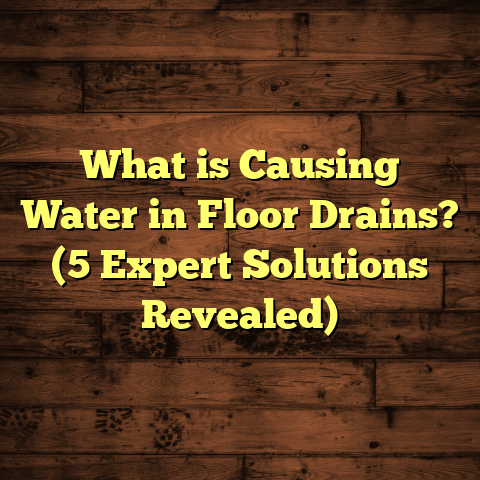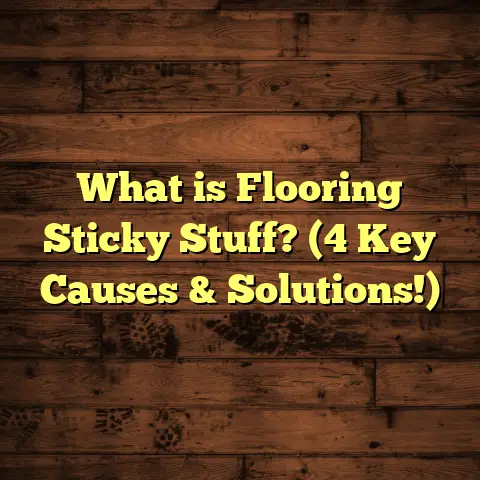What is a Floor Burnisher? (5 Benefits for Pristine Floors)
Comfort is something I always think about when working on floors. You might not notice it right away, but the floor beneath your feet plays a huge role in how comfortable a space feels. Whether you’re standing in your kitchen making dinner or walking through a busy office, the state of the floor affects how welcoming and cozy the environment feels. I’ve spent years working with different types of flooring, and one tool that has consistently helped me bring out the best in floors is the floor burnisher. If you’ve never heard of one before, or if you’re curious about what it does and why it matters, stick with me—I’ll walk you through everything I’ve learned.
What is a Floor Burnisher?
Let’s start with the basics. At its core, a floor burnisher is a machine designed to polish hard floor surfaces by spinning a pad or brush at high speeds. This process smooths out the floor’s finish and brings out a glossy shine. The word “burnish” might sound fancy, but it simply means to polish or rub to make something smooth and shiny. Imagine rubbing a pair of leather shoes until they gleam—that’s burnishing, just on a bigger scale for floors.
Floor burnishers come in all shapes and sizes. Some are lightweight and portable, perfect for small areas like homes or small offices. Others are larger, commercial-grade machines used in shopping malls, hospitals, or schools where there’s a lot of floor space to cover.
What makes these machines special is their speed and efficiency. Unlike traditional mops or hand buffers that take forever and sometimes leave streaks or dull spots, burnishers spin at thousands of revolutions per minute (RPM). This high speed generates enough friction and heat to polish away dirt buildup, scuff marks, and minor scratches that accumulate over time.
How Does It Work?
Burnishers use rotating pads made from materials like synthetic fibers or natural hair. These pads press against the floor while spinning rapidly. The friction created heats the floor surface just enough to soften old wax or finishes so they can be smoothed out evenly. This results in a uniform shine that looks fresh and clean.
Different pads have different levels of abrasiveness. Soft pads are used for gentle polishing on delicate surfaces like hardwood or vinyl. Harder pads can handle tougher materials like concrete or terrazzo floors.
I remember my first time using a burnisher on a client’s lobby floor—it was vinyl composite tile, old and dull from years of foot traffic. After just one pass with the burnisher and a medium-abrasion pad, the floor looked transformed. The shine was back, and the client couldn’t stop smiling.
My Journey with Floor Burnishers: Successes and Challenges
Over several years as a flooring contractor, I’ve had plenty of experience with burnishers—both good and bad. Let me share some stories that highlight how this tool helped me achieve great results, as well as lessons I learned when things didn’t go as planned.
Success Story: Revitalizing a School Gym
One of my favorite projects involved a local school gymnasium that had seen better days. The floor was covered in scuff marks from basketball shoes and gym equipment. It was dull and looked neglected.
The school wanted a cost-effective way to brighten up the space without replacing the entire floor. I recommended using a high-speed floor burnisher with an aggressive polishing pad designed for resilient flooring.
After thoroughly cleaning the floor to remove dust and debris, I started the burnishing process. It took several hours over two days to cover the large area properly, but the results were incredible. The shiny finish returned as if the floor had been brand new.
The principal told me afterward that teachers, students, and parents all commented on how much better the gym looked and felt. It was rewarding to see how something as simple as burnishing could boost school spirit.
Challenge: Hardwood Floor Mishap
Not every job with a floor burnisher has been smooth sailing. I learned this firsthand when I tried burnishing a hardwood floor that had an old finish but wasn’t sealed properly.
Because hardwood is softer than tile or concrete, it requires careful handling. Unfortunately, I underestimated how delicate this particular floor was.
Using a standard high-speed burnisher with a medium-abrasion pad created heat that was too intense for the finish. Instead of restoring shine, it caused uneven patches and light burns on the wood surface.
I had to stop immediately and recommend professional refinishing for that floor. This experience taught me to always assess the floor type carefully before using a burnisher—and to test on small areas first.
Other Challenges
- Noise: Burnishers are loud machines—some can produce noise levels over 90 decibels. This makes them impractical for use during business hours in offices or retail stores. Scheduling burnishing sessions after hours or on weekends is essential to avoid disrupting occupants.
- Weight and Maneuverability: Larger commercial models can be heavy and difficult to maneuver in tight spaces. For residential work or smaller jobs, I prefer lighter machines that allow me more control.
- Pad Wear: Pads wear down over time and need replacing regularly to maintain effectiveness. Using worn pads can result in poor polishing or even damage to floors.
Despite these challenges, the benefits of using a floor burnisher far outweigh the drawbacks when used correctly.
5 Benefits for Pristine Floors
I always highlight these five benefits when talking to clients who want their floors looking great.
1. Brings Back the Shine
Floors lose their shine due to dirt buildup, foot traffic abrasion, and old wax layers breaking down. Burnishing removes this dullness by polishing the surface back to its original finish.
In research papers from cleaning industry experts, floors treated monthly with burnishers maintained an average gloss rating of 85 out of 100 compared to only 60 for traditional mop-and-buff cleaning methods.
One example from my experience: A corporate office building’s lobby floors looked lifeless after years of heavy use. After implementing regular burnishing into their maintenance routine, they reported floors looking “newer” even after three years compared to before.
2. Saves Time and Effort
Traditional waxing or buffing requires multiple steps—stripping old wax, applying new coatings, drying time—which can take days for large areas.
Burnishers can polish large areas quickly without stripping or coating layers each time. Medium-sized commercial units cover up to 15,000 square feet per hour.
During a hotel renovation project, I polished their entire lobby floor in less than two hours using a burnisher—something that manual buffing would have taken an entire day to complete.
3. Reduces Need for Harsh Chemicals
Burnishing physically smooths surfaces without relying heavily on chemical strippers or waxes that may harm floors over time.
This reduces chemical exposure risks for building occupants and cleaning staff while being more environmentally friendly.
One green cleaning company reported cutting chemical use by 50% after switching to regular burnishing combined with mild detergent cleaning.
4. Extends Floor Life
By maintaining protective finish layers through regular burnishing, floors resist scratches and wear longer.
Industry data suggests consistent burnishing extends floor life by up to 20%, delaying costly replacements or refinishing jobs.
In practice, I’ve seen clients save thousands of dollars by avoiding premature floor replacement thanks to diligent burnishing maintenance.
5. Improves Safety
Polished floors reflect light better—brightening hallways, retail spaces, and lobbies which improves visibility and reduces trip hazards.
Burnishing also removes slippery wax buildup or dirt residues that cause slips.
A healthcare facility client noticed fewer slip incidents after introducing monthly burnishing into their cleaning schedule.
Technical Insights: Choosing the Right Equipment
If you decide to try burnishing yourself or hire someone for it, here are some detailed tips on equipment selection based on my experience:
- Machine Type: For residential use or small spaces (under 1,000 sq ft), lightweight electric models between 300-600 RPM work well. For commercial areas over 5,000 sq ft, high-speed machines running at 1,500-3,000 RPM are more efficient.
- Pad Selection:
- Soft pads (white) are best for delicate floors like hardwood or laminate.
- Medium pads (red) work on resilient vinyl or linoleum.
- Hard pads (black) are suited for concrete or terrazzo.
- Special diamond-impregnated pads exist for stone floors to avoid scratching.
- Pad Maintenance: Always clean pads after use and replace when worn below recommended thickness (usually around ½ inch).
- Power Source: Electric corded models provide continuous power but require cable management. Battery-powered models offer mobility but limited run times (typically 1-2 hours).
Prep Work: Setting Floors Up for Success
Before you start burnishing, thorough preparation is key:
- Sweep or vacuum all dust and debris.
- Mop floors with neutral cleaner to remove surface grime.
- Dry completely—wet floors can cause traction issues.
- Check for any damages such as deep scratches or cracks that need repair first.
- Test burnish a small hidden area to ensure no adverse reaction from heat or friction.
Skipping prep can mean uneven polishing or even damage during burnishing.
Maintenance Tips After Burnishing
Once your floors gleam after burnishing, maintenance becomes easier:
- Use microfiber dust mops daily to prevent dirt buildup.
- Avoid harsh cleaners with acids or abrasives.
- Schedule regular burnishing sessions every 1-3 months depending on traffic.
- Spot clean spills immediately to avoid stains setting in finishes.
- Consider applying a light coat of maintenance polish if recommended by your flooring manufacturer.
Case Studies: Real-Life Examples
Case Study 1: Retail Store Chain
A regional retail chain faced complaints about dull floors affecting customer perception. Their cleaning team introduced weekly burnishing sessions along with daily sweeping and mopping.
Within three months:
- Customer satisfaction scores related to store cleanliness improved by 25%.
- Floors maintained an average gloss rating of 80/100.
- Cleaning staff reported saving 4 hours per week compared to previous manual buffing routines.
Case Study 2: Hospital Facility
Hospitals require clean yet safe flooring surfaces with minimal chemical use due to patient health concerns.
A hospital facility manager switched from chemical stripping/waxing every month to bi-monthly burnishing with mild cleaners in between.
Results after six months:
- Chemical usage dropped by 60%.
- Floor surface damage incidents reduced by 40%.
- Slip-related incidents decreased by 15%.
This showed how burnishers can play a role beyond aesthetics—in enhancing safety and sustainability.
Common Questions About Floor Burnishers
I often get asked these questions by clients and homeowners interested in trying out this method:
Q: Can I use a floor burnisher on any type of floor?
A: Not really. They work best on hard surfaces like vinyl, tile, linoleum, concrete, and sealed hardwoods. Avoid unfinished wood or delicate stone tiles unless using specialized pads made for those materials.
Q: How often should I use a burnisher?
A: It depends on foot traffic but generally every 1-3 months for commercial spaces and up to twice yearly for residential areas is sufficient.
Q: Is it expensive to buy one?
A: Basic residential models start around $300-$600; commercial machines range from $1,500-$6,000 depending on features.
Q: Can I rent one instead?
A: Yes! Many hardware stores rent floor burnishers by day/week at reasonable rates if you only need short-term use.
Q: Will it damage my floors?
A: If used properly with correct pads and precautions, no damage should occur. Always test first and do not overdo it.
What I Wish I Knew Starting Out
Looking back at my early days working with floor burnishers:
- I underestimated how sensitive some finishes are to heat generated by high-speed polishing.
- I didn’t realize noise could be such an issue until complaints came from tenants during evening work.
- Proper pad selection was often overlooked initially leading to inconsistent results.
- Scheduling regular maintenance saves way more money in the long run than waiting till floors look terrible.
These lessons shaped how I approach flooring jobs today—with more care and attention that pays off in results everyone notices.
Floor burnishers aren’t just fancy machines—they’re practical tools that help keep floors comfortable underfoot by making them look great while extending their life. Whether you’re managing a busy commercial space or caring for your home’s hardwood floors, understanding how and when to use a floor burnisher can make all the difference between dull floors and ones that shine proudly every day.
If you want advice about specific flooring types or need help choosing equipment tailored for your needs, feel free to ask me anytime—I’m happy to share what I’ve learned over years of hands-on work in this field!





